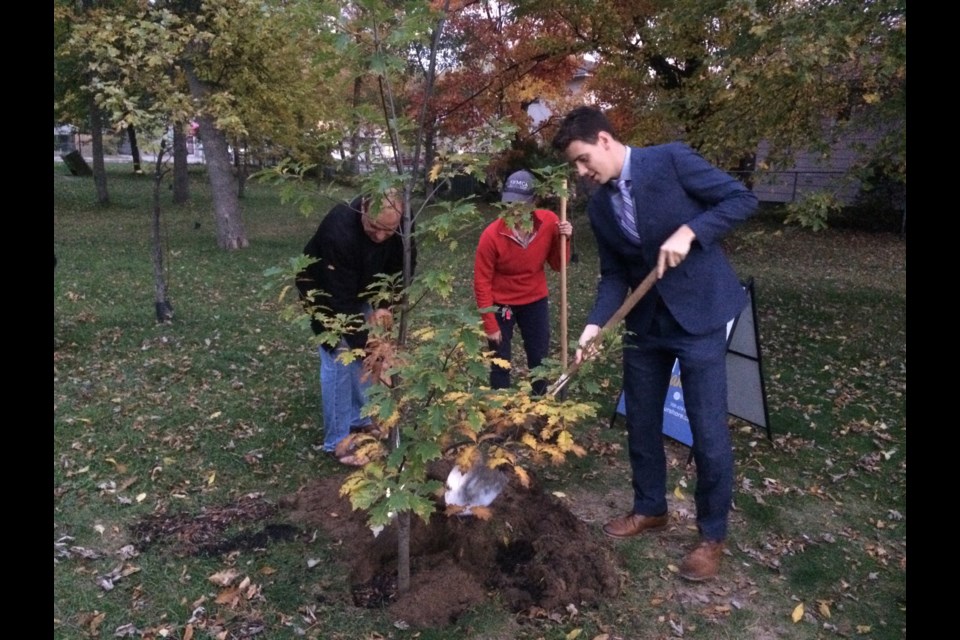The North Bay-Mattawa Conservation Authority is all about partnerships, and since 2012, it has maintained a strong partnership with RBC, starting with the EcoPath program.
Over the past three years, RBC Royal Bank has contributed to the Restore Your Shore program through the authority.
Its latest installment of $15,000, will assist with the planting 1,500 trees, of which 110 will be in the Eva Wardlaw Conservation Area, on Lakeshore Drive in North Bay.
RBC’s total financial commitment to NBMCA environmental programs since the partnership began, is $120,000.
Local branch manager Melissa Yerlitz, said the financial institution recognized the value in the Restore Your Shore program.
“We look at different community partners every year when funding is available, and this one really spoke to the RBC group. So, we’ve been able to contribute year after year since 2012, and it is really amazing to come out to some of these places where there has been tree planting, and see how it has all developed.”
The program started with an advisory committee of approximately 25 stakeholders, which got together to mitigate the issue of blue-green algae.
“The program started in Callander Bay. With a combination of best management practices, monitoring and research, and finding the best ways to tackle the issue of phosphorus, the committee decided a planting program along the shorelines with native species would be the best way to tackle the issue of phosphorus and blue-green algae,” said Reilly Henderson, NBMCA.
“Since it began, we have planted over 2,000 trees, over 10,000 perennials, and over 10,000 shrubs. The length of shoreline in meters that we planted is over 5,000 metres, and the area in square metres if over 27,000. The program now covers the NBMCA entire jurisdiction.”
A full thirty shoreline or stream banked properties were planted this year.
The authority does planting in the spring and again in the fall for the health and survival of the plants.
“Shoreline plantings help prevent erosion and the runoff of unwanted nutrients and pollutants to protect the water quality, and it also helps create habitat for fish and aquatic wildlife,” said Sue Buckle Manager, Communications and Outreach, North Bay-Mattawa Conservation Authority.
“There is no cost involved to property owners. That’s really the gem of this. We’ve raised the funds to be able to do this,” said Buckle.
“Our staff comes out and works with the property owner and develops a planting plan, that takes into consideration the soil conditions and the property owner’s desires for their shoreline property. Some property owners want to retain a view, so we look at planting more deep rooting shrubs. People want to maintain a certain amount of access to their water, which is really reasonable, so the plan that our stewardship staff creates, takes that into consideration.”
The plants are supplied by the conservation authority which is also responsible for the actual planting.
“The property owners commitment is to maintain those plants for five years, to participate in our education and outreach initiatives in terms of allowing their picture to be taken and we post a photograph online on the Restore Your Shore website because some people are really invested in having grass to the shoreline, which is really unhealthy for the water and for the habitat,” said Buckle.
“So we want people to help us educate other people that this is what’s normal, what’s appropriate is to have your shoreline vegetated. It’s healthy, and it is important for the environment,” said Buckle.
“There are people who participated in the project that we’ve gotten really, really positive feedback from. We’re getting calls from people saying how things have grown over those years, and how happy they are with the program.”
The size of the property and the shoreline will dictate how many trees and shrubs will get planted.
“We work with the property owner to say this is how much shoreline you have, this is how much we would recommend planting. Some of it will depend on the plants that we have in stock, because we pre-order plants.”
The conservation authority uses all native species in the plantings.
“Factors to take into consideration are the shoreline, the topography, the soil conditions, the plants we have available, the property owner’s preferences. So, those all come together in developing the planting plan for the property.”
The NBMCA is also interested in agricultural properties.
“We can do planting on agricultural properties that have stream banks, and shorelines, and creeks running through those, so it creates a buffer along the shore between there and wherever the farms are planting or their animals and livestock to help protect the water quality as well.”
The program is available to for cottages, businesses, homes, farms, and recreational-seasonal properties, any place within its jurisdiction that has a shoreline, stream bank, a creek, a river, wetlands. Those are all things that will be looked at and considered.
Each year the program is dependent on funding.



